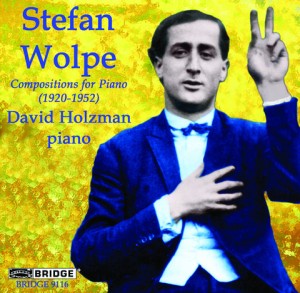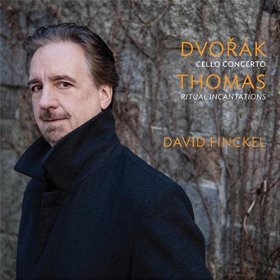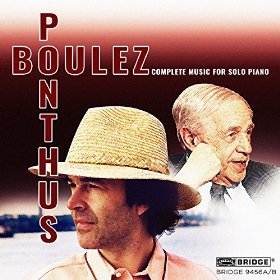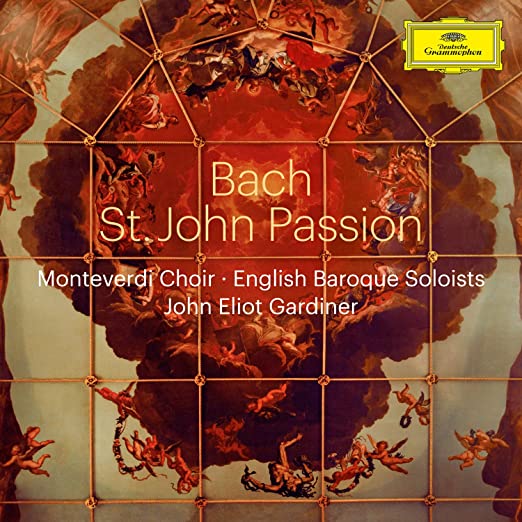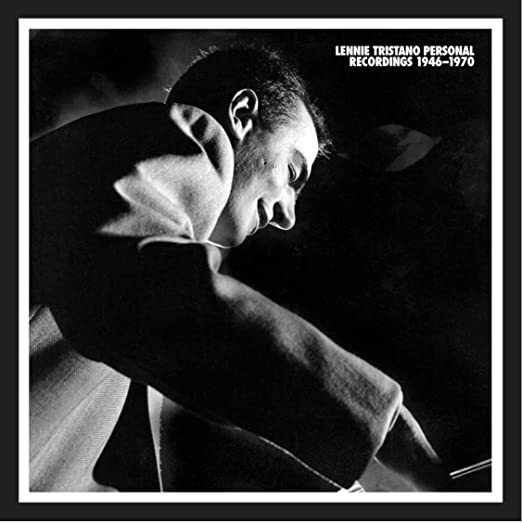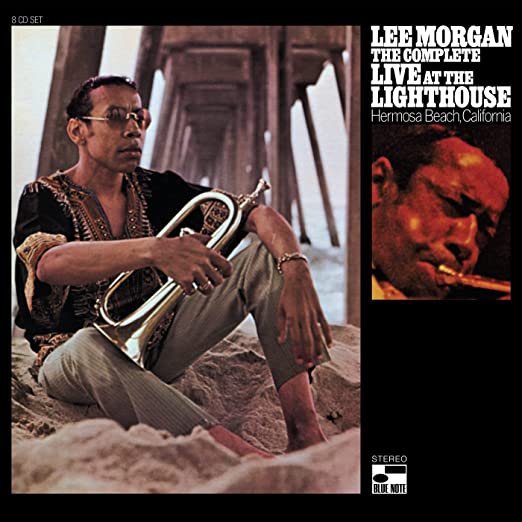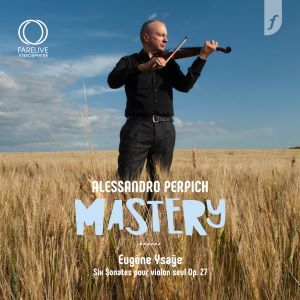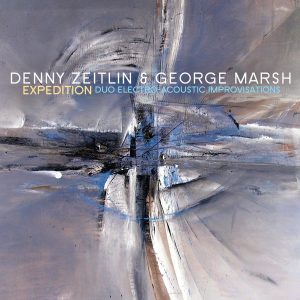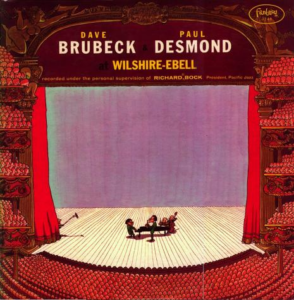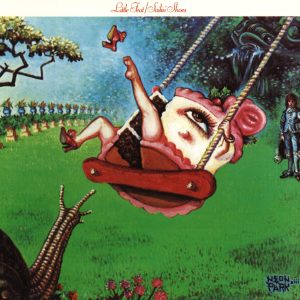Stefan Wolpe. Compositions for Piano, 1920-1952. David Holzman, piano. Bridge 9116.
I decided I couldn't leave Wolpe where I left him last time out. Yes, he can be cerebral but there are other Wolpes whom I really only hinted at, mainly because Four Studies (1935-36) on the Bridge 9344 recording left such a strong impression.
Sonata No. 2 (1925)—its being written a decade earlier is likely a factor—is a different matter. The first movement is effortful and driving. The second is wonderfully forlorn, some of the most appealing music I've heard for a long time—and the main inspiration for this follow-up Wolpe review. It doesn't stay forlorn, picks up a more winsome, even hopeful quality along the way; but an attractive melancholy is the dominant mood. The third and final movement is a return to the driving style but only for a minute and then we're out of it.
Who couldn't love a work called Encouragements for Piano? (1943-47). Short pieces, 24 and a half minutes. Rhythmic, rambling ruminations? Some of the best qualities of the middle movement of Sonata No. 1 but less melancholy. Sometimes coy, sometimes witty, more energetic. Syncopated as it moves into the middle pieces, throwing the mood off beat into something more restless. We seldom hear syncopation used this way. It interpolates a sense of 'maybe' into the musical discourse, undercutting what would otherwise be fairly straightforward. I like it. Encouragements indeed. Zamach Suite (1939): Seven short pieces in eleven and a half minutes—actually melodic, almost a reward for the challenges, rewarding though they are, in Encouragements. There are even a pair of fugues. A delightful work. Yes, Wolpe can delight. The final movement Chaconne is a gas.
Dvorak, Cello Concerto. Thomas, Ritual Incantations. David Finckel, cello. Taipei Symphony Orchestra, Felix Chiu-Sen Chen, conductor. Artistled 28822.
What does it take to "hear" Dvorak's Cello Concerto after all of the many times most of us have heard it by however many cellists and orchestras? I came to this recording with more loyalty to the cellist than excitement for the music. And even then it took me a way into the second movement to realize I was actually listening. To Finckel's cello: to what's missing from the Emerson Quartet these days. To the largely unheralded cellist who has, along with his wife, splendid pianist Wu Han, dedicated so much of his life over the last decade to the public life of music: keeping the Chamber Music of Lincoln Center on track, doing the same to keep the Music@Menlo program flourishing and, with Da-Hong Seetoo, getting its programs recorded. And these are just the activities I'm aware of.
David Finckel's cello: firm, rich, sonorous, inducing me to listen once again to a war horse I was sure had nothing left to offer me. His lyricism and restraint in the final movement moved me more than I was prepared for. While nineteenth century romanticism has been out of favor among sophisticated listeners for a generation, it has never been out of favor in the concert hall; and this recording reminds us why. Finding the balance between the tempered rich and the tastefully lean has never been easy when playing the Dvorak but Finckel finds it, locks onto it, and gives the beloved Czech renewed life.
Complementing this concerto with August Read Thomas's (b. 1964) Ritual Incantations (1999) seemed a curious move until I came to it immediately after the Dvorak. In that position, the Thomas work seems to take off from it, sweeping its romanticism into a modern idiom that frees the cello, letting Finckel become the dominant voice. In some subtle but striking way we can hear the Dvorak behind the Thomas, trying to speak through it. It can't get through but some of its spirit can and Ritual Incantations is the richer for it. In a word, this is an inspired coupling. This is a 2003 recording remastered by the inimitable recording engineer Da-Hong Seetoo, whose work lies behind all of Finckel's, Wu Han's, and the Emerson Quartet's recordings. Come for Finckel, stay for Thomas!
Pierre Boulez, Complete Music for Solo Piano. Marc Ponthus, piano. Bridge 9456 A/B. (2 CD's)
I have always thought of Pierre Boulez as the Ezra Pound of modern music, an artist whose role as cultural entrepreneur, champion, producer, and teacher was more important than his own creative endeavors. Listening to this new album of his solo piano music has caused me to revisit this opinion.
I can't imagine what the score of Piano Sonata No. 2 (1947-48) looks like! Sonically, it is a huge, expansive chrysanthemum-like explosion of notes that quite literally proclaims the aesthetic program Boulez sought to persuade his contemporaries to adopt. The explosion lasts for five minutes or so and then subsides as we drift into a second movement which is as spare and reflective as the first is profuse and passionate. There is no discernible narrative or progression. We are wondering about a quiet landscape, as notes shimmer, whisper, and occasionally prance about us. The overall mood -- an alternative version of the first movement, is one of speculative dissonance. And it grows on us. We become accustomed to its difference from what we would normally take to be music, which is clearly Boulez's aim: to induce us to inhabit a new, alternative musical world. This is his entire aesthetic program -- in his compositions and in his role as cultural prophet. The third movement is an antic version of the second, which flows immediately into a final movement which feels like a recapitulation of the moods that have preceded it. Listening to Pierre Boulez here is like visiting (or being visited by) a world. You didn't know this was possible, he says. But it is. Music can break free of its tradition and become something else. Boulez is the essence of the second generation of modernism, where the revolution of the first generation has been supplanted by its goals. It is post-modernism. I'm not surprised this sonata was set at the head of the program.
The music which succeeds it in the program is interesting, but it almost sounds like footnotes. After two shorter works, Douze [12] Notations (1945) -- elusively intoxicating musical moments—and Incises (2001)—a ten minute exercise or meditation on motion... racing, purposeful pacing, scampering, stalking, darting, stomping... you get the idea, we arrive at Sonata No. 1 (1946). Which is suggestive of a Keith Jarrett improvisation. It does not swing, so we won't call it jazz. But unlike Sonata No. 3 (below), it has a degree of continuity enabling its wanderings and whimsies to mesmerize us. Nine minutes is about the perfect length for such a thing: it leaves us not quite satisfied and wanting a bit more. Then, after four minutes of Une page d'éphémérida (2005), we have Sonata No. 3 (1957-58). What we are given are the first and second parts of a five-part work which the composer never published in its entirety. I pronounce it pure avant-garde impressionism. I do that because modern impressionism was born in France, because Boulez is French, and because there is no other way to make critical or descriptive sense of this music! It is curious dribs and drabs of piano sound which create an atmosphere. It is as if the connective tissue in a Debussy prelude was removed. This is not in the least suggestive of a Keith Jarrett piece—it is its own thing altogether. Not incidental to this album's successes: Pianist Marc Ponthus is a pure joy to listen to.
Bottom line judgment: Ezra Pound and Pierre Boulez were essential to the development of modernism and wrote some arresting works we would be loath to be without.
Equipment used for this audition: Resolution Audio Cantata CD player w/BlackJack power cord; Blue Circle BC 107 solid state preamplifier & NSL 28 watt solid state amplifier, JM Reynaud Offrande Supreme, V2 loudspeakers; Crimson interconnects and speaker cable; and Volex power cables. Mapleshade Samson equipment rack.
Bob Neill, a former equipment reviewer for Enjoy the Music and Positive Feedback, is proprietor of Amherst Audio in Western Massachusetts which sells equipment from Audio Note (UK), Blue Circle (Canada), Crimson (UK), Jean Marie Reynaud (France), Resolution Audio (US), and Tocaro (Germany).




